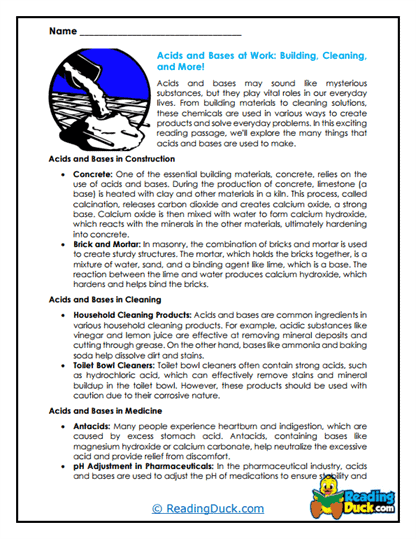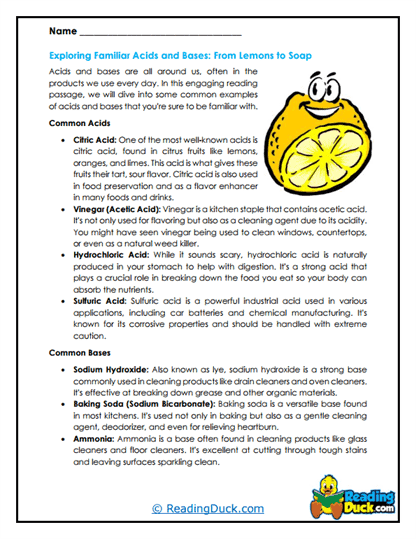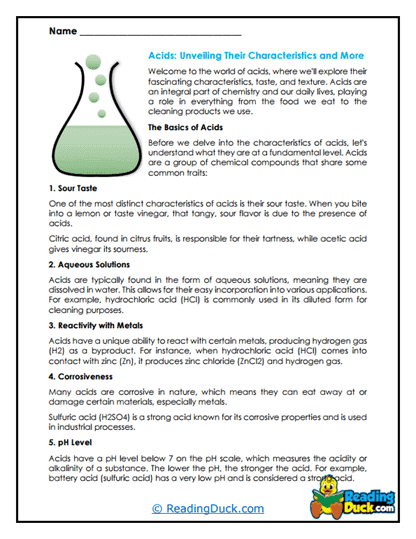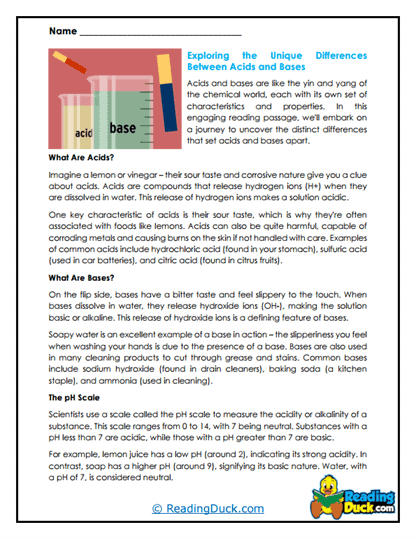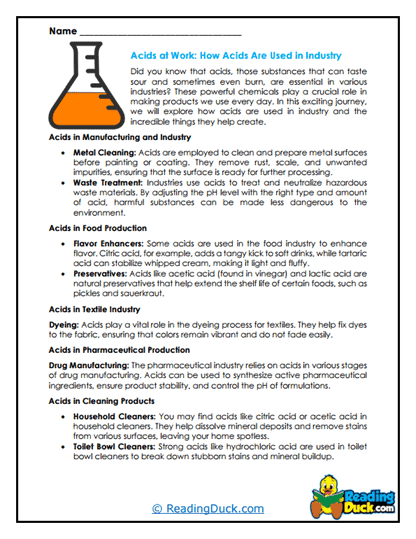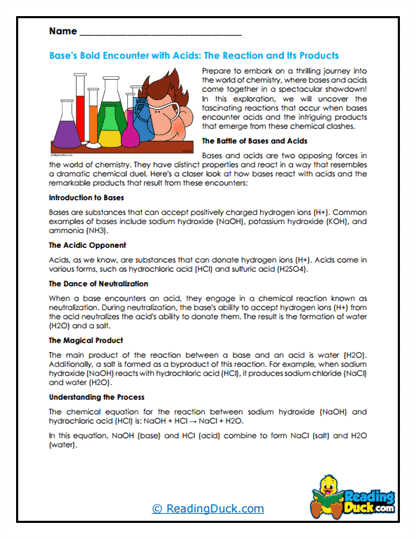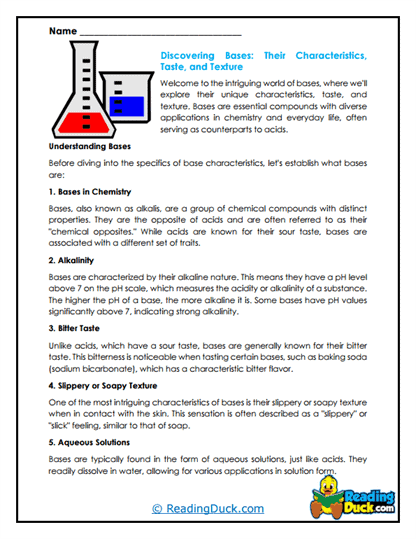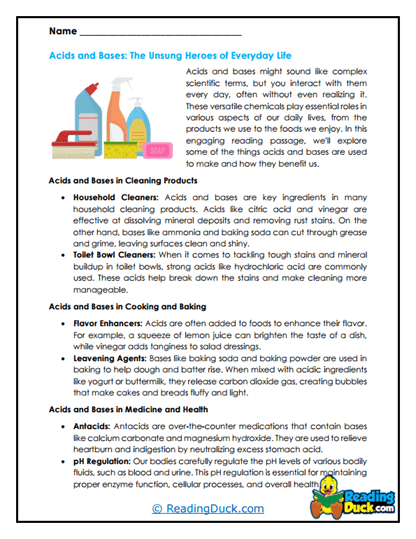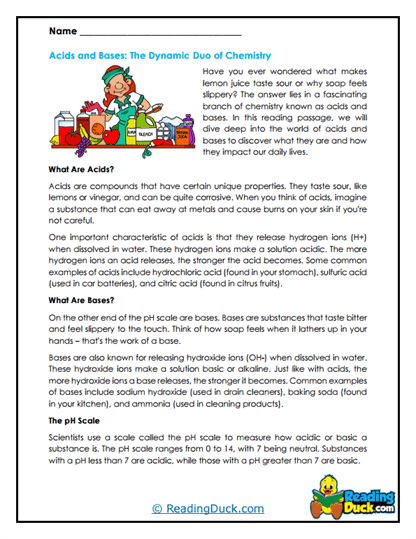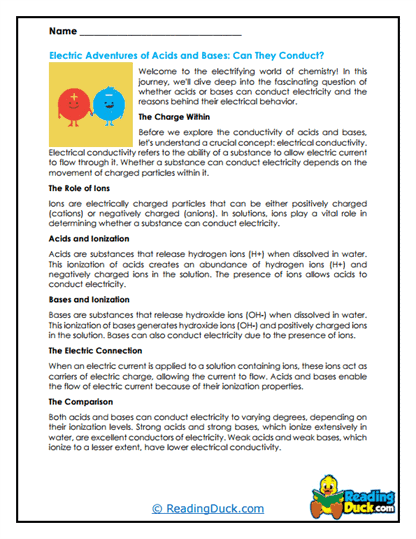Acids and Bases Worksheets
About Our Acids and Bases Worksheets
Our Acids and Bases worksheets are designed to provide a comprehensive understanding of this fundamental topic in chemistry. Acids and bases are central to many chemical reactions and have a wide range of applications in everyday life, from the food we eat to the products we use. This collection dives deep into the properties, behaviors, and significance of acids and bases, making the topic accessible and engaging for students.
Each worksheet set within this collection includes a variety of resources aimed at reinforcing student learning:
- Multiple Choice Questions: These questions test students’ grasp of key concepts such as the pH scale, the characteristics of acids and bases, and the reactions they undergo.
- Short Answer Questions: These prompts encourage students to articulate their understanding in their own words, covering topics such as identifying acids and bases in everyday substances or explaining neutralization reactions.
- Open-Ended Questions: These questions allow students to explore the topic more deeply, offering their insights and opinions on subjects like the environmental impact of acids and bases or the role of acids and bases in industrial processes.
These worksheets not only assess comprehension but also enhance students’ connection to the material by encouraging critical thinking and personal reflection. An answer key is provided for each question sheet, ensuring that students can check their work and teachers can facilitate discussion and feedback. All worksheets are available as PDF files, making them easy to view, download, and print.
Understanding Acids and Bases: The Chemistry of pH
Acids and bases are essential concepts in chemistry that explain the behavior of various substances in different contexts. Here’s how a teacher might introduce this topic to their students:
1. The Basics of Acids and Bases:
- Definitions and Properties:
- Acids: Substances that release hydrogen ions (H⁺) in solution, giving them a sour taste and the ability to corrode metals. Common examples include hydrochloric acid (HCl) in stomach acid and citric acid in citrus fruits.
- Bases: Substances that accept hydrogen ions or release hydroxide ions (OH⁻) in solution, resulting in a bitter taste and a slippery feel. Examples include sodium hydroxide (NaOH) used in soap making and ammonia (NH₃) in cleaning products.
- The pH Scale:
- Measurement of Acidity and Alkalinity: The pH scale ranges from 0 to 14, with values below 7 indicating acidity, above 7 indicating alkalinity (basicity), and a pH of 7 representing neutrality, such as in pure water.
- Applications of pH: Understanding pH is crucial in many fields, including medicine, agriculture, and environmental science. For example, maintaining the pH balance of blood is vital for human health, while soil pH affects plant growth.
2. Chemical Reactions Involving Acids and Bases:
- Neutralization Reactions:
- Acid-Base Reactions: When an acid and a base react, they neutralize each other, forming water and a salt. This reaction is fundamental in processes such as titration, where it helps determine the concentration of an unknown solution.
- Real-Life Applications: Neutralization reactions are used in everyday life, such as in antacids that neutralize stomach acid, or in agriculture, where lime (a base) is added to acidic soil to improve crop yield.
- Indicators and Their Use:
- Litmus Paper and Other Indicators: Indicators are substances that change color in response to the pH of a solution. For example, litmus paper turns red in acidic conditions and blue in basic conditions. Other indicators, such as phenolphthalein and methyl orange, are used in laboratory settings to identify the pH of solutions.
- Environmental Indicators: pH indicators can also be used to monitor environmental conditions, such as checking the acidity of rainwater (acid rain) or testing the pH of natural water bodies to ensure they are safe for aquatic life.
3. The Role of Acids and Bases in Daily Life:
- Household Uses:
- Cleaning Products: Many household cleaning agents are either acidic or basic. For instance, vinegar (acetic acid) is used to clean windows, while baking soda (sodium bicarbonate) is a mild base used to neutralize odors.
- Food and Cooking: Acids and bases are also present in the foods we eat. For example, baking powder contains a base that helps baked goods rise by reacting with acids in the dough to produce carbon dioxide gas.
- Industrial Applications:
- Manufacturing Processes: Acids and bases are crucial in various industrial processes. Sulfuric acid, for example, is used in battery production and in the manufacture of fertilizers, while bases like sodium hydroxide are essential in the production of paper and textiles.
- Environmental Impact: The release of acidic or basic substances into the environment can have significant consequences. Acid rain, caused by industrial emissions of sulfur dioxide and nitrogen oxides, can harm ecosystems, while alkaline waste can contaminate water sources.
By exploring these aspects, students can develop a comprehensive understanding of acids and bases, appreciating their relevance to both scientific study and everyday life.
Activities to Supplement These Worksheets
To further enhance students’ understanding and engagement with the topic of acids and bases, here are some suggested activities that teachers and parents can incorporate into their lessons:
1. Hands-On Experiments:
- pH Testing with Everyday Items:
- Objective: Allow students to test the pH of common household substances such as vinegar, baking soda, lemon juice, and soap using pH paper or a digital pH meter.
- Discussion: Encourage students to predict the pH of each substance before testing and discuss why different substances have varying pH levels.
- Neutralization Reaction Experiment:
- Objective: Conduct a simple experiment where students mix an acid (like vinegar) with a base (like baking soda) to observe the neutralization reaction, resulting in the production of carbon dioxide gas.
- Discussion: Discuss the practical applications of neutralization, such as its role in relieving heartburn or treating acidic soils.
2. Creative Assignments:
- Acid-Base Comic Strip:
- Objective: Have students create a comic strip that illustrates a story involving acids and bases. For example, a character might use an acid to clean, but then needs to neutralize it with a base.
- Discussion: Use this creative exercise to reinforce the properties and reactions of acids and bases in a fun and memorable way.
- Acid-Base Role Play:
- Objective: Organize a role-playing activity where students act out a scenario involving acids and bases. One student could play the role of an acid, another a base, and others as indicators or neutral substances.
- Discussion: This interactive approach helps students personify the chemical reactions they’ve learned about, making the concepts more relatable and easier to understand.
3. Real-World Connections:
- Field Trip to a Water Treatment Plant:
- Objective: If possible, arrange a visit to a local water treatment facility where students can see how pH is managed in the purification process.
- Discussion: After the visit, discuss the importance of maintaining proper pH levels in drinking water and how it relates to public health.
- Research Project on Acid Rain:
- Objective: Assign students to research the causes and effects of acid rain, including its impact on the environment, buildings, and human health.
- Discussion: Have students present their findings and suggest ways to mitigate the effects of acid rain, tying the project back to the concepts of acids and bases.
4. Technology Integration:
- Interactive Simulations:
- Objective: Use online simulations that allow students to virtually mix acids and bases, observe pH changes, and explore the outcomes of different reactions.
- Discussion: These simulations provide a safe and controlled environment for students to experiment with more hazardous chemicals, reinforcing their understanding of the topic.
- Digital pH Logbook:
- Objective: Encourage students to keep a digital logbook where they record the pH levels of various substances they test over a week.
- Discussion: This activity promotes consistent observation and reflection, helping students see the broad range of pH in their everyday surroundings.
By supplementing the worksheets with these activities, teachers and parents can provide a well-rounded educational experience that not only covers the theoretical aspects of acids and bases but also connects them to real-world applications. These exercises encourage students to explore chemistry in an interactive and engaging way, deepening their understanding and appreciation of the subject.
